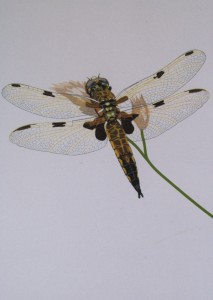 It is not too late to see the last of the dragonflies and damselflies for this summer and there can be no better place in the Highlands than Loch Bran. This comparatively small roadside loch is just to the south of Loch Ness near Foyers, surrounded by trees, and is a haven for a wide variety of fauna and flora. A sunny day can reveal a of host of wildlife such as birds, dragonflies, butterflies and many aquatic plants. It is, for example, one of the few places in the north where both frogs and toads breed in the same loch and there is always the chance of seeing little grebes and occasionally even the very rare Slavonian grebes. A recent visit produced the large and impressive golden-ringed dragonfly, a few black darters, a four spottet chaser, see photograph, and several common blue damselflies. The black darters were still busy pairing up, mating and laying their eggs on the beds of Sphagnum mosses at the water’s edge. The male darters looked very black whilst the females were mainly a contrasting golden yellow. They are the smallest of the darters and have been on the wing as adults since as early as July.
It is not too late to see the last of the dragonflies and damselflies for this summer and there can be no better place in the Highlands than Loch Bran. This comparatively small roadside loch is just to the south of Loch Ness near Foyers, surrounded by trees, and is a haven for a wide variety of fauna and flora. A sunny day can reveal a of host of wildlife such as birds, dragonflies, butterflies and many aquatic plants. It is, for example, one of the few places in the north where both frogs and toads breed in the same loch and there is always the chance of seeing little grebes and occasionally even the very rare Slavonian grebes. A recent visit produced the large and impressive golden-ringed dragonfly, a few black darters, a four spottet chaser, see photograph, and several common blue damselflies. The black darters were still busy pairing up, mating and laying their eggs on the beds of Sphagnum mosses at the water’s edge. The male darters looked very black whilst the females were mainly a contrasting golden yellow. They are the smallest of the darters and have been on the wing as adults since as early as July.
To my mind the golden-ringed dragonfly is one of the most impressive of insects with a wing span of up to over 100 mm. The female has the longest body of all the British dragonflies. The golden rings are all around the black body and both male and females are completely gold and black apart from the large green eyes. Even their legs are black. They are unusual in the British dragonflies as they lay their eggs in flowing water although when feeding they are not confined to such areas. Apart from the burns and slow rivers where they breed they range far and wide in their search for food. This is one of the reasons they are at Loch Bran, to feed. In practice they will patrol an area for a long time searching for insects. I often see them hawking for food along narrow roads in Strathnairn. Ironically the short time we see them in the summer months is only a small part of their lives. The larvae of the golden-ringed dragonfly can spend between two to five years under water before it emerges as an adult. The number of years depends on food availability and water temperature. As adults they will fly between early June and mid-September and then, once they have mated and laid their eggs, they all die with the onset of winter. The superb illustration of the golden-ringed dragonfly is by Ben Cormack who lives in the Isle of Eigg.
Loch Bran has one of the most extensive beds of white water lilies anywhere in the Highlands and, earlier this month, because of the late season this year, they were all still in full flower and very impressive indeed. The beds stretched almost all over the loch and the only open area was a wide strip along the north side. There is another much more open and larger area of the loch on the east side but this is nowhere as good for wildlife as the, albeit smaller, western section. The reason is that the western part is shallow over a very large part and this is just right for a wide range of aquatic freshwater plants to flourish. Interestingly the open woodland glades around the loch’s margins still attract speckled wood butterflies and some were still on the wing although very tattered.
